/Vehicles/Axis/Germany/02-mPanzers/PzKpfw4/File/5-Models(L43-48).htm | Last Up-date: 26-04-2018
Panzerkampfwagen IV Medium Tank
Pz.Kpfw IV Models (75 mm KwK L/43 & L/48)
Le Panzerkampfwagen IV Ausf.G (Sd.Kfz.161/1 mit 1 75 mm KwK L/43) résulte de la constatation que le 75 mm KwK L/24 était insuffisant pour percer les blindages des chars soviétiques tels que le KV-I ou le T-34/76; constatation faite sur le front en 1941. Un canon possédant une plus grande vitesse initiale susceptible de percer le blindage de ces tanks était devenu nécessaire. En novembre 1941, Hitler ordonna donc l'adoption d'un canon plus long procurant en effet cette grande vitesse initiale, le 75 mm KwK 40 L/43.
Panzerkampfwagen IV Ausf.G (Sd.Kfz.161/1 mit 75 mm KwK L/43): results from the observation that the 75 mm KwK L/24 was insufficient to pierce the shieldings of the Soviet tanks such as Kv-I or T-34/76; observation made on the front in 1941. A gun having a higher initial speed likely to pierce the shielding of these tanks had become necessary. In November 1941, Hitler thus ordered the adoption of a longer gun getting indeed this high initial speed, the 75 mm KwK 40 L/43.
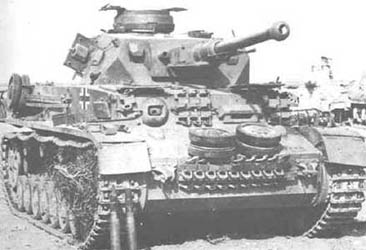 |
Pz.Kpfw IV Ausf.F2 |
src: site Photos
Gallery of WW2
|
En mars 1942, le Pz.Kpfw IV Ausf.F sera en effet réarmé avec le KwK L/43 munis d'un frein de bouche à déflecteur unique. Ces chars seront rebaptisé F2 par les ouvrages occidentaux d'après-guerre, mais pour les Allemands, pendant la guerre, ces chars étaient considérés comme des Pz.Kpfw IV Aus.G au même titre que le Pz.Kpfw IV Aus.G plus tardifs dotés du KwK L/48 à frein de bouche à double déflecteur.
In March 1942, the Pz.Kpfw IV Ausf.F will indeed be rearmed with L/43 with muzzle brake with single deflector. These tanks will be renamed F2 by Western postwar books, but for the Germans during the war, these tanks were considered as true Pz.Kpfw IV Aus.G alongside late Pz.Kpfw IV Aus.G with the KwK L /48 with the muzzle brake with double deflector.
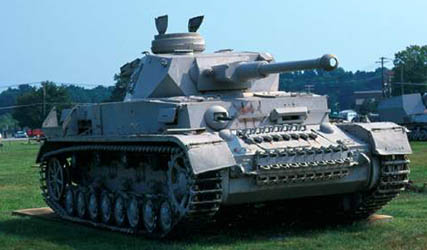 |
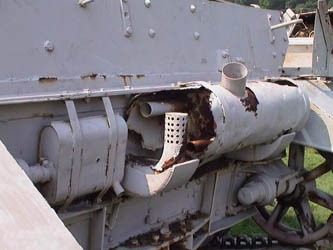 |
Panzerkampfwagen
IV Ausf.F2 (Aberdeen Museum) |
|
|
|
|
Le Panzerkampfwagen IV Ausf.G (Sd.Kfz.161/2 mit 1 75 mm KwK L/48): Les derniers modèles voient l'apparition du frein de bouche à double déflecteur qui deviendra standard. Sur la tourelle on remarque l'absence des sabords de vision latéraux. Sur les trappes du O.R. et du pilote, les mini trappes de signalisation sont désormais supprimées.
Panzerkampfwagen IV Ausf.G (Sd.Kfz.161/2 mit 75 mm KwK L/48) : The last models see the appearance of the muzzle brake with double deflector which will become standard. On the turret one notices the absence of the side ports of vision. On the hatches of the R.O. and the pilot, mini signal hatches now are removed.
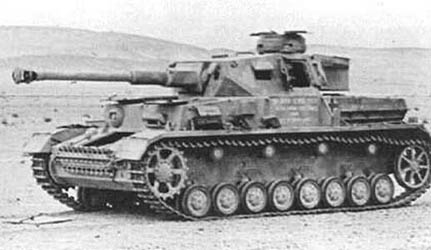 |
Pz.Kpfw IV Ausf.G |
src: Site www.wwiivehicles.com
|
Certains Ausf.G seront équipés de jupes blindées (Schürzen) et de coupole avec trappe d'un seul tenant, voir du canon 75 mm KwK 40 L/48 et son tube plus long. De plus certains modèles seront équipés d'appliques blindés épais de 30 mm ajoutés sur les parties frontales de la caisse et de la superstructure.
Certains Ausf.G will be equipped with armoured skirts (Schürzen), cupola with one-piece hatch, and 75 mm KwK 40 L/48 gun and its longer tube. Moreover certain models will be equipped with 30 mm armoured brackets added on the frontal parts of the hull and the superstructure.
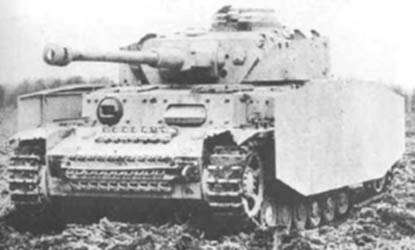 |
Pz.Kpfw IV Ausf.G
mit Schürzen |
src: site Photos
Gallery of WW2
|
Data |
Drawings |
Le Panzerkampfwagen IV Ausf.H diffère de l'Ausf.G par la standardisation des appliques blindés (sur le nez et la plaque frontale de la superstructure) de 30 mm et de l'adoption définitive du 75 mm KwK 40 L/48. Les modèles de fin de production seront fabriqués avec un blindage frontal de 80 mm. L'antenne-radio est maintenant relocalisé à l'arrière du côté gauche de la superstructure dans une position fixe. L'Ausf.H est également équipé des jupes blindées épaisses de 5 mm "Schürzen" protégeant les côtés de la caisse (montées sur châssis dentelés) et le pourtour de la tourelle (sauf à l'avant). Sur la coupole on pouvait installer une MG 34 anti-aérienne.
Panzerkampfwagen IV Ausf.H differs from Ausf.G by the standardization of the armoured brackets (on the nose and the frontal plate of the superstructure) of 30 mm and of the final adoption of the 75 mm KwK 40 L/48. The models of end of production will be manufactured with a frontal shielding of 80 mm. The radio antenna is now relocated to the back of the left side of the superstructure in a fixed position. Ausf.H is also equipped with the thick armoured skirts of 5 mm "Schürzen" protecting the sides of the hull (mounted on notched frames) and the circumference of the turret (except with before). On the cupola one could install an anti-aircraft MG 34.
 |
Pz.Kpfw
IV Ausf.H mit Schürzen |
src: Site www.wwiivehicles.com |
L'Ausf.H voit également l'adoption de la pâte anti-magnétique Zimmerit appliquée sur les parois verticales. Le sabord de vision frontal du chargeur est supprimé à l'avant de la tourelle. De nouveaux barbotins plus légers sont également adoptés. Certains modèles seront équipés de rouleaux porteurs tout acier et de nouvelles poulies de tension de chenille (moulées). Le seul point qui permet de reconnaître à coup sure l'Ausf.H de l'Ausf.J est l'absence sur ce dernier du silencieux en forme de boîte du moteur auxiliaire (rotation de la tourelle) présent sur la gauche de la plaque arrière de la caisse.
Ausf.H also sees the adoption of the Zimmerit antimagnetic paste applied to the vertical walls. The frontal port of vision of the loader is removed in front of the turret. New lighter sprocket-wheels are also adopted. Certain models will be equipped with any steel return rollers and new rear idlers (moulded). The only point which makes it possible to recognize with all the blows Ausf.H and Ausf.J, is the absence on this last of the silencer in the shape of box of the auxiliary engine (rotation of the turret) present on the left of the back plate.
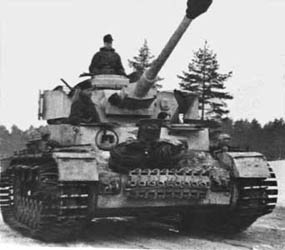 |
Pz.Kpfw IV Ausf.H |
src: Site "Juggernauts
of the second world war"
|
Data |
Drawings |
Le Panzerkampfwagen IV Ausf.J fut mis en service en mars 1944, et représente l'étape finale du développement de Panzer IV. L'Ausf.J avait comparé à Ausf.H une conception simplifiée, en effet les ports de la vision du O.R. et du pilote ont été enlevés comme les ports du tir de pistolet et de vision des trappes de la tourelle. Le moteur de rotation de la tourelle a été également enlevé comme son silencieux sur la plaque arrière de la caisse.
Panzerkampfwagen IV Ausf.J was introduced in March 1944, represents the ultimate stage of the development of Panzer IV. Ausf.J had compared to Ausf.H a simplified design, indeed the ports of vision of the R.O. and the pilot were removed as well as the ports of pistol shooting and vision of the hatches of the turret. The traverse engine of the turret was also removed like its silencer on the back plate of the hull.
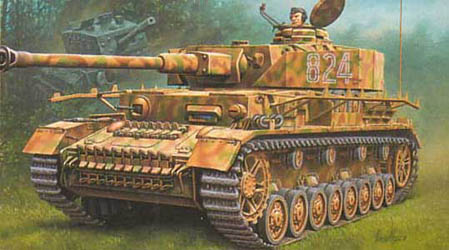 |
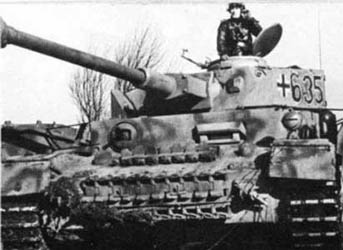 |
Pz.Kpfw
IV Ausf.J mit Schürzen |
|
L'Ausf.J sera également équipé de nouveaux rouleaux de retour tout acier et de nouvelles poulies de tension moulées. Comme l'Ausf.H, l'Ausf.J a été équipé de Schürzen. Une version dé l'Ausf.J, le Panzerbeobachtungswagen IV Ausf.J (char d'observation) fut équipée d'un poste radio additionnel et d'une deuxième antenne montée sur le côtée droit de la plaque arrière de la superstructure.
Ausf.J will be also equipped thereafter with new any steel return rollers and a new moulded rear idlers. Like Ausf.H, Ausf.J was equipped with Schürzen. A version of Ausf.J, Panzerbeobachtungswagen IV Ausf.J (tank of observation) was equipped with an additional radio station and another antenna on the right side of the back plate of the superstructure.
Data |
Drawings |
Un des inconvénients deuPanzer IV, c'est
qu'il ne possédait pas les parois inclinées (parois
avec un meilleur profil ballistique) qui étaient utilisés
pour le Panther et le Tiger II. La conception du Panzer IV était
rigoureusement germanique avec un maximum des murs verticaux. Cependant
l'adoption de tels parois aurait avantageusement prolongé la
vie de Panzer IV (si la guerre avait continué naturellement)
et aurait fait de ce dernier modèle alternatif tout à
fait avantageux au panthère, plus lourd et moins fiable.
Au niveau du nez cette disposition du blindage aurait procuré
un bénéfice de poids qui aurait soulagé les bogies
et la transmission, mal rencontré par tous les Panzers IV.
Un nouveau n'aurait pas été nécessaire, cette
modification aurait été disponible sous forme de kit
montable sur le champ de bataille ce qui aurait été
tout à fait meilleur marché. Ce kit aurait été
disponible pour les modèles G/H/J. Les modèles équipés
ainsi auraient été baptisé Panzerkampfwagen
IV Ausf.K1.
Une version du K1, le Panzerkampfwagen IV Ausf.K2 devait être équipée de générateurs de la fumée.
Le Panzerkampfwagen Ausf.L comme Ausf.K devait avoir un avant avec parois inclinés et un blindage de 80 millimètres. L'économie dans le poids aurait permis de pousser le blindage frontale de la tourelle à aussi 80 millimètres. Le tube du canon devait être équipé d'un extracteur de vapeur comme celui du tank destroyer américain M36 Jackson.
One of the disadvantage of Panzer IV, it is that it did not have the tilted walls (walls with best ballistic profiles) which were used for the Panther and Tiger II. The design of Panzer IV was rigorously Germanic with a maximum of vertical walls. However the adoption of such walls would advantageously have prolonged the life of Panzer IV (if the war had continued of course) and would have made of this last quite advantageous alternate model to the Panther, heavier and less reliable.
On the level of the nose such a provision of the shielding would have saved a profit of weight which would have relieved the bogies and the transmission, bad met by all Panzer IV. A very new vehicle would not have been necessary, this modification would have been available in the form of field mountable kit what would have been quite cheaper. This kit would have been available for models G/H/J. The models thus equipped would have been baptized Panzerkampfwagen IV Ausf.K1.
A version of K1, Panzerkampfwagen IV Ausf.K2 was to be equipped with the generators of smoke.
Panzerkampfwagen Ausf.L as Ausf.K was to have a front with inclined walls and a shielding of 80 mm. The saving in weight would have made it possible to push the shielding frontal of the turret to also 80 mm. The tube of the gun was to be equipped with a vapor extractor like that of the American tank destroyer M36 Jackson.
Le 31 décembre 1942, Krupp reçoit l'ordre de redessiner le Panzer IV en prenant exemple sur le T-34 et les plans du Panther. Il ne s'agit plus ici de plaques d'acier rajoutée sur la structure originelle du Panzer IV mais d'une toute nouvelle architecture (blindage frontal de la tourelle: 50 mm, de la caisse: 80 mm). Ce nouveau dessin augmente cependant le poids du char de 880 kg. Cet inconvénient est jugé comme mineur car sur les terrains les équipages de Panzer IV avaient déjà l'habitude d'augmenter le poids de leur char en l'agrémentant d'une protection de fortune (comme des éléments de chenille). La toute nouvelle architecture (inclinée) aurait rendu cette protection de brick et de broc superflue. Cependant en raison de rapports de combat il fut demandé à Krupp d'augmenter le blindage latéral et arrière pour contrer les redoutables fusils antichars PTRD-41 de l'armée rouge, qui passe à 45 mm. Malheureusement le poids du char passe à 27.2 tonnes. On pense un temps monter des chenilles plus larges de type Ostketten (Winterketten) pour réduire la pression au sol à 0.72 kg/cm2, mais cela alourdirait le char encore d'une tonne. La fiabilité des composants mécaniques, comme la boîte de vitesse, les freins, les galets de roulement... ne pourrait plus être garantie de manière satisfaisante. Cela aurait aussi engendré une nette dégradation de la mobilité tactique, avec l'effondrement du rapport puissance/poids, car le moteur lui restait d'origine !
Hitler sous recommandation de la Panzerkomission, décida le 17 février 1943, de ne pas donner son aval à ce nouveau projet provoquant plus de problèmes qu'il en résolvait. De plus les changements dans la chaîne de production auraient nécessité l'arrêt complet de celle-ci pendant un mois et une reprise en mode mineur. Hitler décida donc de conserver le Panzer IV tel quel et le doublement des cadences de production du Panzer IV classique, dès octobre 1943.
On December 31, 1942, Krupp was ordered to redesign the Panzer IV, taking the example on the T-34 and the Panther's plans. This is no longer the solution of steel plates added to the original structure of the Panzer IV but of a brand new architecture (frontal armor of the turret: 50 mm, the glacis: 80 mm). This new design however increases the weight of the tank of 880 kg. This disadvantage is considered minor because on the ground the crews of Panzer IV were already used to increase the weight of their tank by decorating it with a field customized protection (like track elements). The new architecture (inclined) would have made this field customized protection superfluous. However, because of combat reports, Krupp was asked to increase the lateral and rear armor to counter the formidable Red Army PTRD-41 anti-tank rifles, which rose to 45 mm. Unfortunately the weight of the tank goes up to 27.2 tons. For a while, it is thought that larger Ostketten (Winterketten) tracks will be fitted to reduce the ground pressure to 0.72 kg / cm2, but it would weigh a ton more. The reliability of the mechanical components, such as the gearbox, the brakes, the road-wheels ... could no longer be satisfactorily guaranteed. This would also have led to a significant deterioration of tactical mobility, with the collapse of the power/weight ratio, because the engine was still original!
Hitler, on the recommendation of the Panzerkomission, decided on February 17, 1943, not to give its approval to this new project causing more problems than it solved. In addition, the changes in the production chain would have required a complete shutdown of the production line for a month and a re-start in minor mode. Hitler therefore decided to keep the Panzer IV as it was and the doubling of production rates of the classic Panzer IV, as early as October 1943.
Drawings |
Sources:
- Pz.Kpfw IV in action, Armor Number 12 (squadron/signal publications, inc.)
- Connaissance de l'Histoire (Hachette) - N°17 - " Les chars de combat allemands 39-45"
- Connaissance de l'Histoire (Hachette) - N°5 - " Véhicules blindés allemands 39-45"
- Les Blindés de la Seconde Guerre Mondiale (Atlas)
- Panzerkampfwagen IV Medium Tank 1936-1945 (Osprey Military) - New Vanguard N°28
- Site "Achtung Panzer" - http://www.achtungpanzer.com
- Site "Germany's vehicle history" - http://www.wwiivehicles.com
- Site "Second World War Armour" - http://www.onwar.com/tanks/index.htm





/Bt-off.jpg)